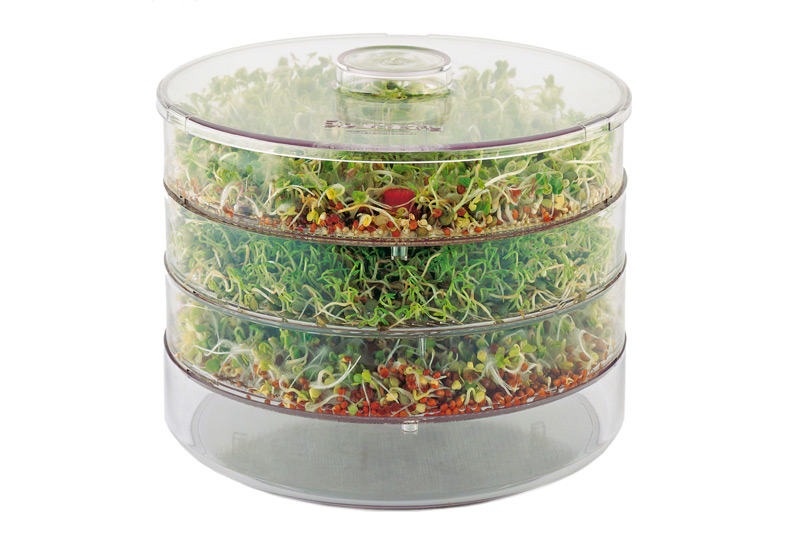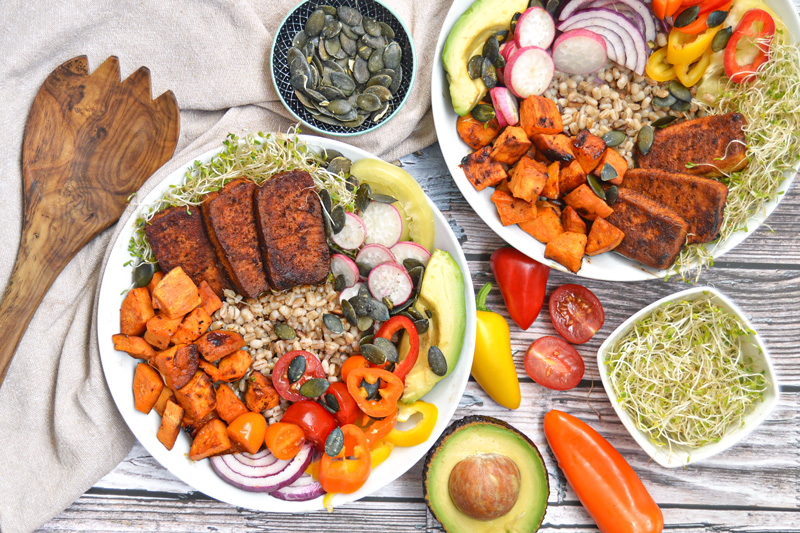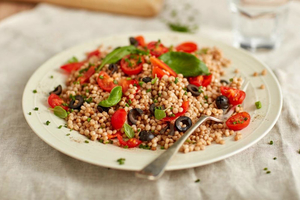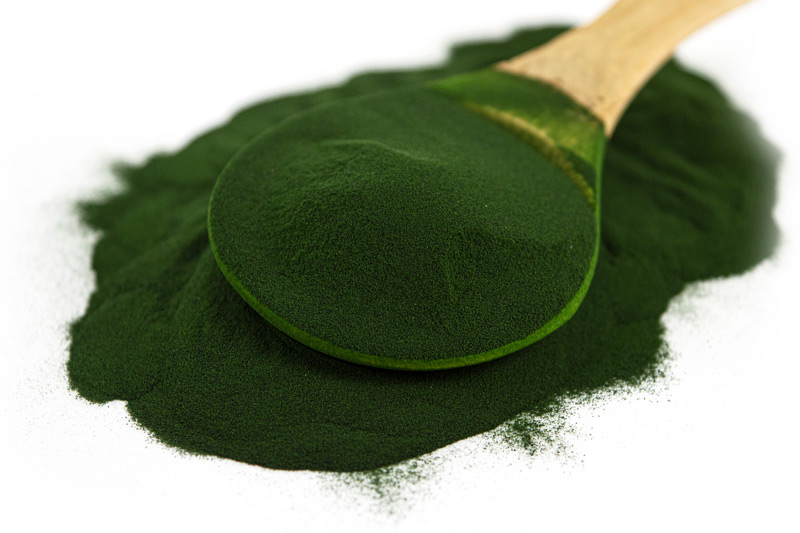Articles
You may have been to a fancy restaurant where meals have been served topped with a little tangle of colourful microgreens, very young plant shoots that have just emerged from their seeds. They certainly look great, but are they there just to make your meal more pretty, or is there any nutrition in them?
We’re very happy to say these eager little fast-growing sprouts are superstars when it comes to packing a nutritional punch. Dainty and delicately-flavoured they may be, but in terms of vitamins, minerals and all kinds of fantastically beneficial plant compounds, they’re hugely robust, and offer more goodness than the vast majority of plant foods.
So let’s take a closer look at the wonders of sprouting and investigate why everyone should get their own sprouting operation up and underway!
Read More »There are bacteria living just about everywhere in our bodies – on the surface of our skin; in our ears, nose and mouth, and – in vast numbers – inside our digestive system. Many people might regard bacteria as dirty, and something we should rid ourselves of – but the ones in our gut actually work in harmony with us, and we couldn’t survive without the benefits they bring. They’re essential for a huge array of bodily processes connected with our health and wellbeing, including our happiness levels, our skin, our hormone balance, our energy levels and our immune system.
Each one of us has a complex, thriving microcosm of bacteria within our gut, and the happier they are, the happier and more healthy we are. For this reason, it’s important for us to foster the most favourable conditions we can for them, and this involves making sure we eat the things we know they like!
In recent years, research has uncovered increasing evidence that the bacteria that end up in our gut can be transferred to and from the people we spend our time with.[1] For this reason, it’s a good idea to ensure our nearest and dearest also eat a gut bacteria-friendly diet too! So let’s look at how we can create the finest conditions for a healthy, happy gut ecosystem….
Read More »Period pain is crippling for many women. It can involve tummy cramps, pain in the back and thighs and intensely painful spasms. These can profoundly affect mood, and have a negative effect on family life and relationships. 90% of women report having painful menstrual cramps.[1] Researchers from the British Medical Journal found that menstrual cramps cause women to lose an average of 9 days’ productivity at work every year.[2]
During periods, the womb wall contracts vigorously so the lining can be shed. This puts pressure on the blood vessels surrounding the womb, which in turn cuts off the supply of oxygen-enriched blood momentarily, setting off a chain reaction causing womb tissue to release pain-triggering chemicals. Other chemicals called prostaglandins are also released, which cause the womb muscles to contract even more, which takes the pain level higher.
It’s important to have a supply of good sanitary towels – reusable ones are excellent – as well as mood-improvers such as some Essential Oils in an Oil Burner, some lovely crisps (Eat Real‘s range is good), and some good quality Dark Chocolate (which contains plant compounds that can also help the body form more nitric oxide, which dilates blood vessels, thereby increasing blood flow). Other popular options are having a relaxing massage or a long, luxurious soak in a hot bath, with some lovely bubblebath.
There are some lesser-known ways you can reduce the effects of period pain too, though – so let’s take a look at a few of these….
Read More »The skin is the largest organ in the human body. It’s constantly exposed to the oxidising effects of the air around us, the sun’s ultraviolet rays, growing amounts of pollution in the atmosphere and a whole host of chemicals from household cleaners, soap and other products. Add increasing levels of allergies to the mix, and there are many reasons dry skin can occur.
We all know it’s important to ensure our skin has enough moisture, and a good moisturiser can help with this, as long as we ensure they don’t contain ingredients that may actually be counter-productive, such as alcohol and artificial fragrances, which can be drying and dehydrating to the skin in the long run.
Many people know of topical treatments and supplements for dry skin, which include Aloe Vera, Hyaluronic Acid, Evening Primrose Oil and Coconut Oil, but instead of treating sensitive skin with lotions and supplements, why not fix it from the inside out with diet? Glowing, healthy skin always feels better combined with some tasty food! So let’s look at seven ways you can improve your skin through what you eat….
Read More »Diabetes is a real and growing problem. The charity Diabetes UK predicts that by the year 2030 there will be 5.5 million diabetics in the UK.[1] The NHS calculates that treating diabetes in the period 2018/19 cost £1.07 billion.[2] This is only set to grow as diabetes rates explode – figures show that there are now more than twice the number of people living with a diagnosis of the condition in the UK than there were in 1998.[3]
Added to this, we are an extremely sedentary nation, even more so with the rise of streaming TV, coupled with phone technology which mean we can be informed, entertained and fed without really having to move from the sofa. Sitting for long periods is thought to slow the metabolism, which affects the body’s ability to regulate blood sugar, blood pressure and break down body fat.[4]
You may have heard of Dr Michael Mosley, a medical doctor and BBC broadcaster who created an 8-week ‘blood sugar diet’ which purports to combat high blood sugar levels and in some cases reverse type 2 diabetes.[5] This does work – but it’s a very hard slog getting through it! So let’s look at some other changes you can make to reduce the damage to your body caused by diabetes, and ensure you can fill up on delicious food at the same time….
Read More »We’ve all heard that Protein is an essential part of our diet and that we should always ensure we get enough of it, but what is protein? How much protein should we be eating? And what does protein do for us exactly?
Proteins (often called ‘the building blocks of life’) are large molecules with complex structures made up of amino acids, and are found in many foods. When eaten, they play a pivotal role in our biological processes. They are essential for building and repairing bodily tissues, regulating the functions of our organs, protecting us from viruses and bacteria, transporting molecules around the body and helping babies and youngsters grow.
The NHS advises adults to eat 55.5g of protein daily for men and 45g for women, although we should avoid eating more than twice this amount. So what are the best ways to get protein? Let’s take a closer look….
Read More »Spinach is, quite simply, one of the very healthiest foods you can put into your body. This amazing plant is perhaps the most nutritionally dense food in common use in the UK, and can provide a massive boost to the health and wellbeing of you and your family.
Many people grew up watching Popeye cartoons on TV, and remember him gaining colossal strength after eating tinned spinach, and although the effects of this leafy green aren’t usually so immediate, there is truth in the idea that spinach goes a long way towards making your body fit, lean and ready for action.
So let’s take a closer look at the health benefits of Spinach, and why you should be eating more of this wondrous plant….
Read More »You may have heard various claims about the many health benefits of Fenugreek, but what’s the truth behind the hype? What is Fenugreek, and can it really boost our health as well as making our food tasty?
Fenugreek (often called Methi) is a plant commonly associated with India, but now also grown in the Mediterranean, the Middle East, China and Canada. The seeds are usually roasted in a pan before being ground – this lessens their natural bitterness and gives them a more rounded, mellow, nuanced flavour. They’re commonly used in a variety of curry dishes, mainly for flavour but also sometimes as a thickening agent; the leaves are also eaten in salads, and the seeds can be sprouted to produce lip-smackingly tasty and wonderfully nutritious microgreens.
We all love a good curry, and it’s good to know that one of the ingredients could be doing good things for us – so let’s take a closer look at how Fenugreek can improve our health and wellbeing….
Read More »You may have heard of the Acai berry – most of us have probably received spam emails promising weight loss miracles with Acai pills, and while there’s no magic bullet for weight loss, Acai has risen to prominence in the top rank of superfoods. But what is Acai?
Acai (pronounced a-sigh-ee) is the name of a palm tree which grows in South America and the Caribbean. It gives its name to the small black berries which grow on it. These are a staple food in the Amazon River delta, along with the hearts of palm which come from the same tree. In recent years, ‘acai bowls’ have become popular in health food circles – these usually contain a whole host of healthy wholefoods such as nuts and fruit along with a good helping of acai berry powder or pulp.
So what’s the truth about the health benefits of Acai? Let’s have a detailed look….
Read More »Chlorella’s fantastic nutritional profile means it’s classed as a superfood. Over half its weight is made up of protein, and not only that – it’s a complate protein, meaning it contains all nine essential amino acids necessary for life. But what is Chlorella, and why should we be using it?
Chlorella is a single-celled green algae that thrives in freshwater lakes. It converts sunlight into energy through a process of photosynthesis, and contains the super-healthy green pigment chlorophyll as a result. It also contains some very potent antioxidant compounds, and it’s a great source of iron, and a very decent source of Vitamin C and a range of B-vitamins. There’s also a good amount of calcium, magnesium, copper, zinc and potassium.
Taste-wise, Chlorella has been likened to Kale and Spinach, and many people take it in capsule form although it’s also popular whizzed up in smoothies. But what are the health benefits of Chlorella? Let’s take a look….
Read More »









